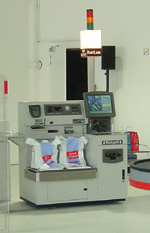Aug 13, 2004To demonstrate how RFID tags on individual products can speed customers through checkouts, retailing technology provider NCR has installed an RFID-enabled self-checkout register at Metro Group’s RFID Innovation Center in Neuss-Norf, Germany. To create what NCR says is the world’s first self-checkout solution with an integrated RFID reader, the company took one of its existing NCR FastLane units, which come with a built-in bar code scanner, and fitted with it an RFID upgrade kit. NCR designed the kit specifically for Metro’s RFID Innovation Center, a stimulated store that Metro opened in July so its suppliers could experience RFID technology in a retail setting (see Metro Launches RFID Test Center).
Back in October 2002, Dayton, Ohio-based NCR first unveiled its prototype hybrid register, which reads both RFID tags and bar code labels, but that device included an UHF RFID reader from Alien Technology. The new system for the Metro Group uses a 13.56 MHz RFID reader manufactured by Feig Electronic. The reader works alongside the unit’s existing bar code scanner. “This means the RFID tag on an item can be read at the same time as the bar code,” says Dan White, who is known as the “technical evangelist” for RFID in NCR’s retail solutions division.
At Metro’s Innovation Center, the hybrid checkout system’s RFID capabilities are being used to deactivate the security function of an item’s RFID tag at the same time the unit scans the item’s bar code label during the checkout process. In a store setting, that would enable the customer to exit the store without triggering a security alarm. The Metro Innovation Center has security gates that can detect if an item’s RFID tag is still activated and, if it is, signal a security alarm.
However, NCR maintains that theft prevention is just one of a number of RFID-enabled applications the system can be used for. The hybrid registers could also be used to kill an item’s RFID tag so that the tag could no longer be read after the item has been purchased. In addition, retailers could use an RFID tag’s additional item-specific information, such as the item’s expiration date, to ensure that customers are alerted to any problems with their purchase.
Metro says that it has no immediate plans to install the hybrid self-checkout registers in its Extra Future Store, the supermarket that Metro opened in Rheinberg, Germany, to showcase a range of emerging technologies. The reason, the retailer says, is that there are currently too few individually tagged items in the store to make it worthwhile. The Extra Future Store does, however, already have 15 NCR FastLane self-checkout stations, which customers use to check themselves out by means of the unit’s bar code scanner. In addition, by early 2005, Metro will install FastLane self-checkout units at 50 of its Real and Extra stores in Germany to supplement the stores’ conventional checkout lanes.
NCR believes hybrid checkout registers that read both RFID tags and bar code labels will become increasingly common as RFID tagging grows at the item level. “We see hybrid systems as the first step for RFID checkouts as individual and item-level tagging progresses over the next 10 years or so,” says White.


